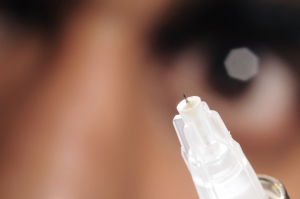Researchers at Georgia Institute of Technology and Emory University in Atlanta have developed a system of microneedles to deliver drugs to the back of the eye. The research team’s findings appear in the July issue of the journal Investigative Ophthalmology & Visual Science (paid subscription required).
The microneedles were devised to meet a need for delivery systems for drugs to treat diseases of the eye, such as macular degeneration, a need expected to grow as the population ages. The most commonly used methods today are injection by hypodermic needle into the center of the eye, and eye drops that are considered less effective.
The microneedle system developed by first author Samirkumar Patel and colleagues targets the suprachoroidal space of the eye, which provides a natural passageway for drug injected across the white part (sclera) of the eye, to flow along the eye’s inner surface and subsequently into the back of the eye. The microneedles are made of stainless steel and less than one millimeter in length.
Patel and colleagues tested the system on rabbits, which showed the test solution flows directly over the choroid and adjacent retina, which are often the targets of drugs for the eye. As important, the molecules and particles largely avoided the lens or front part of the eye, where side effects from drugs can occur.
The tests indicated that solutions given with microneedle delivery not only reached the target structures in the eye, they remained at the target for extended time periods. This property could make the technique feasible for time-release drugs that in turn could reduce the number of injections.
Georgia Tech has licensed the microneedle technology to Atlanta start-up company Clearside Biomedical, which is commercializing the system. Patel, a postdoc at Georgia Tech when the research was conducted, is now the company’s research director. Clearside started operations in January 2012, and attracted some $4 million in financing from North Carolina venture company Hatteras Venture Partners.
Read more:
- Eye Treatment Delivery Option to Syringe Being Developed
- Ophthalmology Drug Delivery Start-Up Gets $4M Investment
- Laser Technique Developed for Microscale Tissue Engineering
* * *


 RSS - Posts
RSS - Posts
You must be logged in to post a comment.